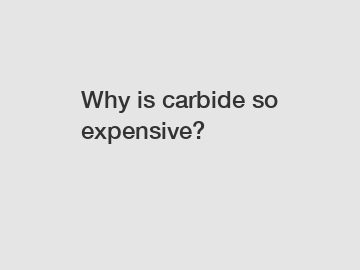Why is carbide so expensive?
Why is Carbide So Expensive?
Carbide is a material known for its remarkable hardness, resistance to wear, and high heat resistance. Commonly used in industrial applications such as cutting tools, mining, and construction, carbide has gained a reputation for being relatively expensive. This begs the question: why is carbide so expensive? Let's delve into this matter and explore the factors contributing to its high price tag.
Point 1: Raw Material Acquisition.

One primary reason for the high cost of carbide is its raw material acquisition. Carbide is primarily made from tungsten carbide powder, combined with a small percentage of cobalt as a binder. Tungsten, one of the main components of carbide, is not readily available and is extracted from tungsten ore through a complex process. The scarcity of tungsten and the energy-intensive extraction process result in high production costs, thereby driving up the overall price of carbide.
Point 2: Manufacturing Process.
The manufacturing process of carbide also contributes to its expensive nature. After acquiring the raw materials, the powdered tungsten carbide and cobalt are mixed and subjected to a high-pressure compaction process known as powder metallurgy. This process creates a dense and uniform structure, enhancing the material's strength and toughness.
Next, the compacted material undergoes sintering, where it is heated to a high temperature in a controlled atmosphere. During sintering, the powdered particles bond together, forming the solid carbide body. The sintering process requires specialized equipment and precise temperature control, which adds additional costs to the manufacturing process.
Point 3: Extensive Industrial Applications.
The widespread usage of carbide in various industries also influences its pricing. Carbide is highly sought after due to its exceptional hardness and wear resistance, making it an ideal material for cutting tools, machining, and mining applications. The extensive demand from these industries has driven up the cost of carbide as suppliers are able to charge a higher price due to its indispensability.
Point 4: Research and Development.
Continuous research and development in the field of material science also contribute to carbide's expensive nature. Over the years, scientists and engineers have made significant advancements in carbide material technology to enhance its properties and performance. This ongoing research incurs considerable costs that are passed on to the end consumers, making carbide a pricier option.
In conclusion, there are several factors that contribute to why carbide is so expensive. These include the costly acquisition of raw materials, the complex manufacturing process, extensive industrial applications, and the ongoing research and development in the field. Carbide's exceptional hardness, wear resistance, and durability make it highly desirable in various industries, leading to a higher demand and subsequently driving up its price. Despite its high cost, the performance and longevity offered by carbide products justify its expense for many applications.
The company is the world’s best tungsten carbide drill bits factory, TBM PARTS, rectangular tungsten carbide blanks for sale supplier. We are your one-stop shop for all needs. Our staff are highly-specialized and will help you find the product you need.

Comments
0